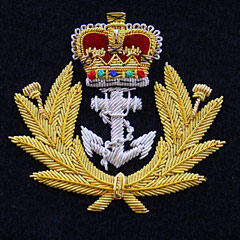
Walter Billett

HMS Monmouth,
Royal Navy
 |  | |
| Boy 1st Class, HMS Monmouth, Royal Navy | ||
| Killed 1st November 1914 |
Walter Billett's Parents | ||
|
Walter Billett was born on 18th November 1896 as the youngest of six children to parents Elihu Billett and Ellen (née Dyer). Elihu is a sufficiently unusual name to have confused enumerators and compositors (type setters) during his lifetime, and continues to confuse modern programs that transcribe census documents now; hence often he shows up as ‘Elisha’ or ‘Elijah’. Elihu's name was in fact taken from a lesser-known biblical character in the book of Job. Elihu came from North Wraxall (between Marshfield and Yatton Keynell), where the Billett name was prolific in the 19th century. Walter’s mother, Ellen (nee Dyer, daughter of Henry & Mary), was from Bath, with records showing her family living in the small courtyards called St Michael’s Court and Hen & Chicken Court off Walcot Street (where Waitrose now stands) before moving out to Cheltenham Street (near the Green Park Tavern). | ||
The Billett Family | ||
| Elihu
Billett and Ellen Dyer married in Bath at St Saviour, Larkhall, in 1885. Elihu was a carter, or 'drayman', and the newly-married couple first lived in Prospect Terrace (a terrace of three houses on the north side of Chilton Road, Camden). 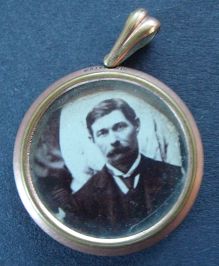  Walter Billett's parents Elihu & Ellen Billett [photos supplied by Yvonne Gibbs, Walter's great-niece] When Walter’s sister Alice was born in 1888 they lived in Albert Terrace, Twerton (tucked away behind Burnham Road), but Florence was born in Lyncombe & Widcombe parish; the 1891 census confirms that Elihu, Ellen and the two daughters had moved into Ellen’s parental home at 14 Cheltenham Street, together with Ellen's brother Henry Dyer junior. This means that there were 5 adults and two children in what we would today consider to be a small terraced house. It seems that Walter’s sister Nellie also arrived to add to the throng at this time. | ||
 |
|
By the time Edward was born, however, the Billetts were briefly living at Brookleaze Buildings in Larkhall (just above Larkhall Square), then at Nias Place (tucked away between Cheltenham Street and the GWR railway line) before returning to Cheltenham Street in 1896, but this time to their own property at number 23, where Walter was probably born. |
|
The houses in Cheltenham Street were all either destroyed or badly damaged during the bombing of World War Two and were subsequently demolished, so the house in which Walter spent the first few years of his life no longer exists. The 1901 census shows the family living – apparently briefly – at 4 Moorfields Cottages. There were two such addresses in Bath at this time; one in Middle Lane, Dolemeads (which became Broadway upon redevelopment early in the 20th century); the other was situated where we now find the junction of Shaftesbury Road and Moorland Road, in Oldfield Park.This latter row of cottages was a continuation north-westward of the buildings in what is now called Shaftesbury Mews. Moorfields Cottages were cleared soon after 1900 to improve road access to the new development in the area of Beckhampton Road, St Kilda’s Road and Faulkland Road; this area was called ‘Durley Park’ when it was built (not to be confused with the road now called Durley Park, near St John’s School). |
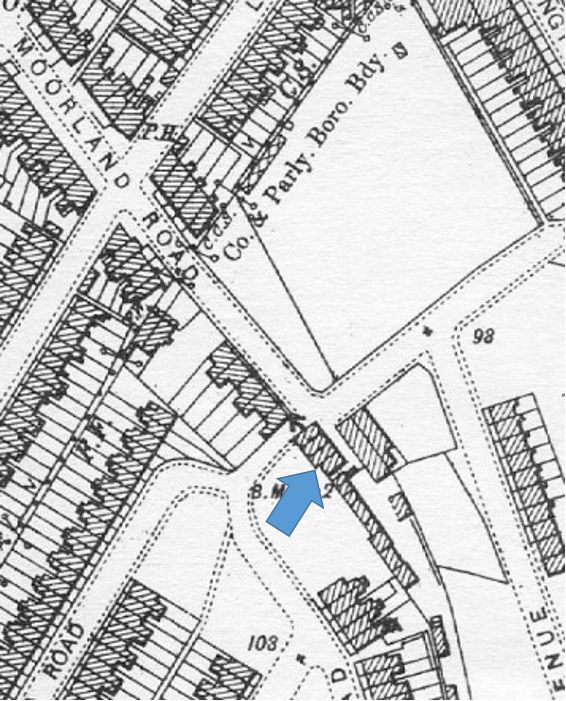 | ||
|
Moorfields Cottages (blue arrow) continued the alignment of Moorland Road towards the (now converted) farm buildings in what is now ‘Shaftesbury Mews’. But they were ultimately cleared to widen Shaftesbury Road and improve access into the new development in the Beckhampton Road area. |
|
From 1902, when Walter was 5 years old, local directories show the family living in Maybrick Road, first at number 17, then (from 1903) at number 11. It is from 11 Maybrick Road that Walter would have walked to school at South Twerton for the majority of his schooldays. During this time, Walter’s father is still shown working as a carter or ‘carman’ (the modern equivalent would be a delivery van driver), then later as a porter, for the Great Western Railway. |
| 11 Maybrick Road |
|
By 1911, census information shows that the family later moved to Pera Road, Walcot, with only the three youngest children at home. Census returns from further afield in the same year show that Walter’s eldest three sisters had entered service. It seems to have been common at this time for those in service to travel some distance from home and family to take up employment. Alice, by now 23, was a parlour maid in a manor house near Sevenoaks in Kent and Florence (21) was a housemaid near Sherborne in Dorset. Nellie, however, seems to have found employment nearer home at a house at Grosvenor Villas (Claremont Road) in Larkhall. At 14, Walter was employed as a milkman and his elder brother Edward (then 17) seems to have followed his father’s footsteps into a job as a carter. We know that Edward was in the coal business from a September 1912 newspaper report of his being admitted to the Royal United Hospital (then in Beau Street) with head injuries after falling from a coal cart. |
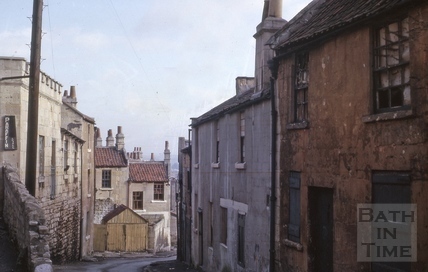 | ||
| Pera Road, Walcot, was Walter Billett's family home at the time he went to war. Seen here as it looked in the 1960s. [Image: Bath In Time] |
| Earlier in 1912 Walter made a cameo appearance as a witness in the trial at the Guildhall of a man from Third Avenue (Oldfield Park) who stole some Dresden china from his employer’s china repair shop and sold it on in Bristol to cover debts. |
Walter Billett in WW1 | ||
Royal Navy
Walter’s Navy record shows that he joined up at the age of sixteen in August 1913, well before the outbreak of war and Kitchener’s subsequent call for volunteers in August 1914. His record shows that he enlisted for a period of twelve years, with this period to take effect from the date of his majority (18th November 1914). In fact Walter never reached his eighteenth birthday. Further details on Walter’s documentation give us a description: 5ft 5¾ inches tall; 34½ inch chest; black hair, blue eyes and a fresh complexion. Distinguishing features are listed as scars on both thighs and a tattoo of a heart on his left arm. HMS Vivid I and HMS Queen
Walter’s first
posting, from 30th August 1913 to 8th January 1914, was
to HMS Vivid I. Although there had
been ships bearing the name 'Vivid',
there was no HMS Vivid afloat at this
time; between 1912 and 1920, HMS Vivid I
was in fact the name of a port-based administrative & training station
only. Walter probably did live and work aboard a ship, however, namely an old
19th century gunboat called HMS
Cuckoo. The hulls of old ships were often converted to accommodation and
training facilities and moored in the vicinity of major Navy stations at
Portsmouth, Dartmouth and Plymouth. Cuckoo
was synonymous with Vivid I at this
time and moored at Plymouth. Walter’s
rank was ‘Boy 2nd Class’; the standard rank for a boy of Walter’s age upon enlisting. | ||
|
From 9th January 1914, Walter was aboard a battleship called HMS Queen and, a couple of weeks later, his record shows that he was promoted to ‘Boy 1st Class’. In April 1914, HMS Queen became a gunnery training ship, stationed at Portsmouth. |
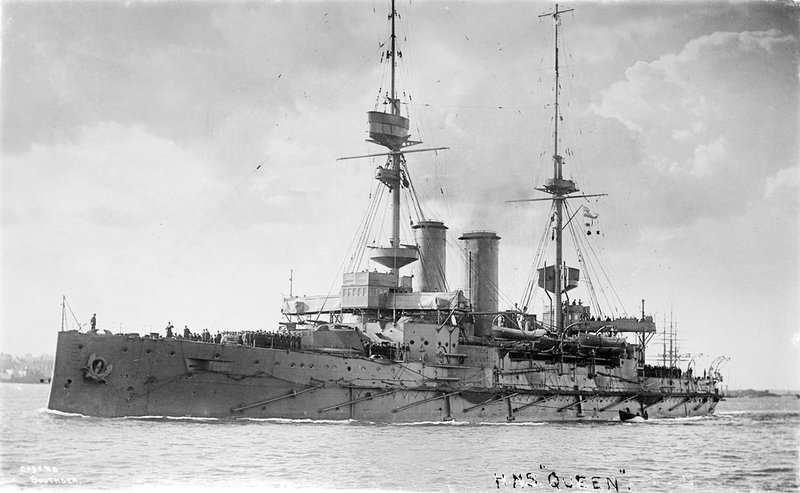 | ||
|
HMS Queen. Walter served on Queen in the first half of 1914. [Image:
Royal Museums Greenwich] |
|
Walter spent only six months on Queen and on 3rd June returned to Vivid I for six weeks. On 20th July he left Vivid I and there is a gap of ten days before his next posting on 30th July. It is possible that Walter was on leave for this period; it may have afforded him a last trip home to his family in Bath; this is speculation, however. HMS Monmouth
HMS Monmouth was an armoured cruiser of the County Class, built in 1903 and carrying nearly 700 crew and officers. Soon after the outbreak of war, Monmouth was part of the South Atlantic Squadron under the command of Sir Christopher Cradock. |
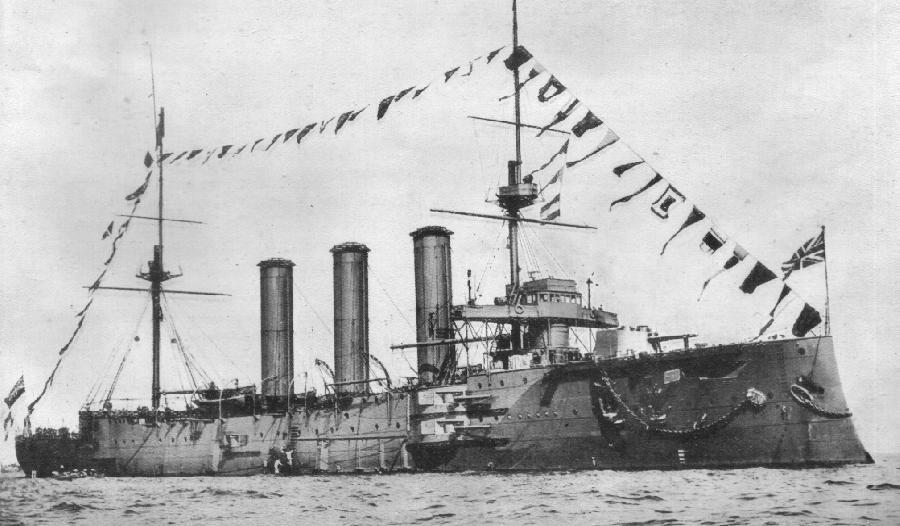 | ||
|
HMS Monmouth, which was sunk with all crew
in the Battle of Coronel on 1st November 1914 [Image: www.coronel.org] |
|
We know HMS Monmouth’s movements in detail from the log of another sailor on board the vessel. Monmouth left Plymouth on 6th August 1914 at 4.30pm. A week later, she arrived at St. Vincent in the Verde Islands, where she stayed overnight before moving on to Pernambuco in Brazil. On 22nd August, Monmouth was joined by the cruiser HMS Glasgow and later by the armed liner Otranto, as Monmouth was in & out of Abrohlos (to the north of Rio de Janeiro, Brazil). Together these ships left Abrohlos on 2nd September. During September, ports of call included Lobas Island (off River Plate), Montevideo (Uruguay), the Straits of Magellan and Orange Bay (Cape Horn). In early October, HMS Monmouth called at Port Edgar on the Falkland Islands, then made her way via the Straits of Magellan and Cape Horn toward the western coast of South America and to Chile. Battle of Coronel, 1st November 1914The Battle of Coronel was a severe defeat for the British Navy at the hands of a small squadron of German ships led by Count Maximilan von Spee off the Chilean coast, near the city of Coronel. Von Spee was in fact heading home to Germany from the Pacific in a squadron of what were considered to be outdated vessels, including the armoured cruisers SMS Scharnhorst and Gneisenau and the light cruisers SMS Dresden, Leipzig and Nürnberg; these were rather slow, but still well armed with large guns and a long range of fire. Given the slow pace of his ships, von Spee does seem to have been fatalistic about his chances of making it back to Germany in one piece. Hence he was making trouble where possible in the South Pacific by attacking shipping convoys and was by no means averse to a confrontation with Cradock’s South Atlantic Squadron when the opportunity arose. Cradock’s squadron was moved from patrol duties in the South Atlantic to try to head off von Spee. Cradock divided his squadron into two and led his fleet around to the western coast of South America, leaving the remainder on the eastern side, in case von Spee gave them the slip. The western fleet included armoured cruisers HMS Good Hope and HMS Monmouth, as well as the light cruiser HMS Glasgow and the converted liner HMS Otranto. These ships were known to have inferior firepower compared with the German vessels; the well-equipped but very slow HMS Canopus had therefore been summoned by the Admiralty to join Cradock’s fleet to provide cover. Canopus’s slow maximum speed of 12 knots meant, however, that it could not keep pace with Cradock’s other ships. Cradock’s requests for more adequate back-up (e.g. from HMS Defence) were not approved. Glasgow was sent to Coronel harbour to pick up messages, but her solo appearance there was observed by German shipping and details radioed to the Leipzig. Glasgow intercepted these radio calls; the interpretation was that the Leipzig was also alone somewhere in nearby waters. Hence Cradock took the risky decision to head up the coast, leaving Canopus behind, whereas the Admiralty’s orders seem to have been in favour of sticking with Canopus at the cost of avoiding an engagement. In fact the Germans were using the Leipzig call sign to cover all the vessels in the fleet. The Germans, in turn, were expecting to meet with the lone Glasgow. |
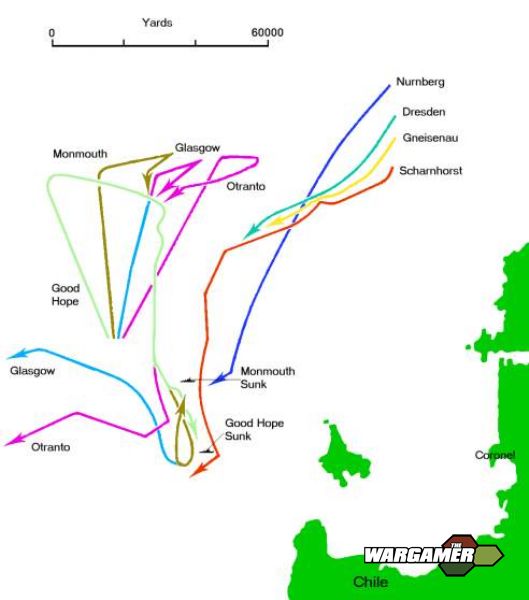 | ||
|
A schematic of the
Battle of Coronel [Image: www.wargamer.com] |
The British
ships, heading north, encountered the German fleet – including the Scharnhorst and Gneisenau
– at distance. Despite the disadvantage of firepower, the British ultimately engaged
the German vessels. It seems the
German ships manoeuvred to maintain a position relative to the British fleet,
such that the British ships were silhouetted against the fading light of the
sky in the west, whereas they themselves were obscured in the growing darkness. In heavy
seas, the German ships Gneisenau and Scharnhorst opened fire from 10km and
were very accurate in spite of the distance. Given that the British ships had a
range of fire nearer 7km, they were already badly damaged before they had any
opportunity of replying in kind. Some reports say it took the German ships
little more than an hour to silence the British guns and put the Glasgow and Otranto to flight, although the Glasgow appears to have chosen to
engage the Dresden and Leipzig briefly before departing. The Monmouth and Good Hope, burning, presented easy targets in the growing darkness
and the Germans proceeded to sink them with little further ado. Damage to
German ships was insignificant. From a contemporary Press Association report: “German
officers bear testimony to the great gallantry of the crew of the Monmouth
which, while in a sinking condition, attempted to ram one of the German
vessels.” |
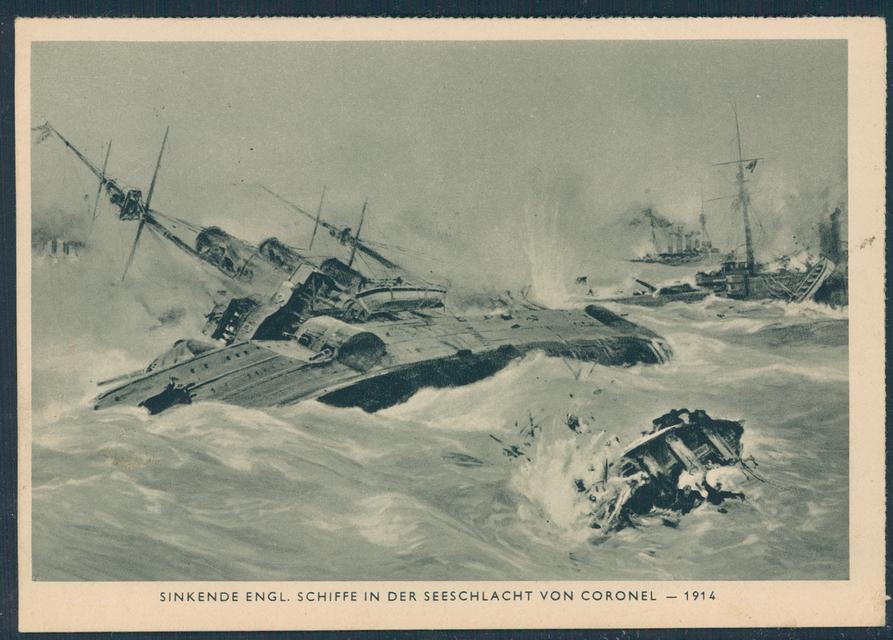 | ||
|
A German propaganda postcard showing
‘sinking English ships at the Battle of Coronel’. In fact the battle took
place in near darkness. (Image from www.germanpostalhistory.com] |
|
Walter Billett’s
war was therefore extremely short and he was the first of the South Twerton men
to fall in the Great War. Reports of
the Battle of Coronel appeared – unconfirmed by the Admiralty – in British
newspapers from 5th November, although details about exactly what
had happened were sketchy. But although even the German reports were unclear
about whether HMS Good Hope had been
sunk or escaped, the sinking of HMS
Monmouth was a certainty. It is therefore possible that Walter’s family learned of his probable
death from newspapers in advance of official notification. Indeed, the
Admiralty’s official response to early reports of the loss of HMS Monmouth included reference to their
surprise that Canopus received no mention
in reports of the battle; this illustrates how Cradock’s decision to leave the Canopus behind was indeed out of step
with official intentions. Von Spee had enjoyed a relatively easy victory, with minimal damage and no losses, but had used a high proportion of his ammunition and was therefore vulnerable. After responding to a telegram order (faked by the British) to head for Port Stanley, he sailed into a British trap, with Canopus opening the firing and von Spee’s slow vessels unable to outrun the superior British ships. Von Spee’s squadron was destroyed in the subsequent Battle of the Falkland Islands on 8th December 1914. |
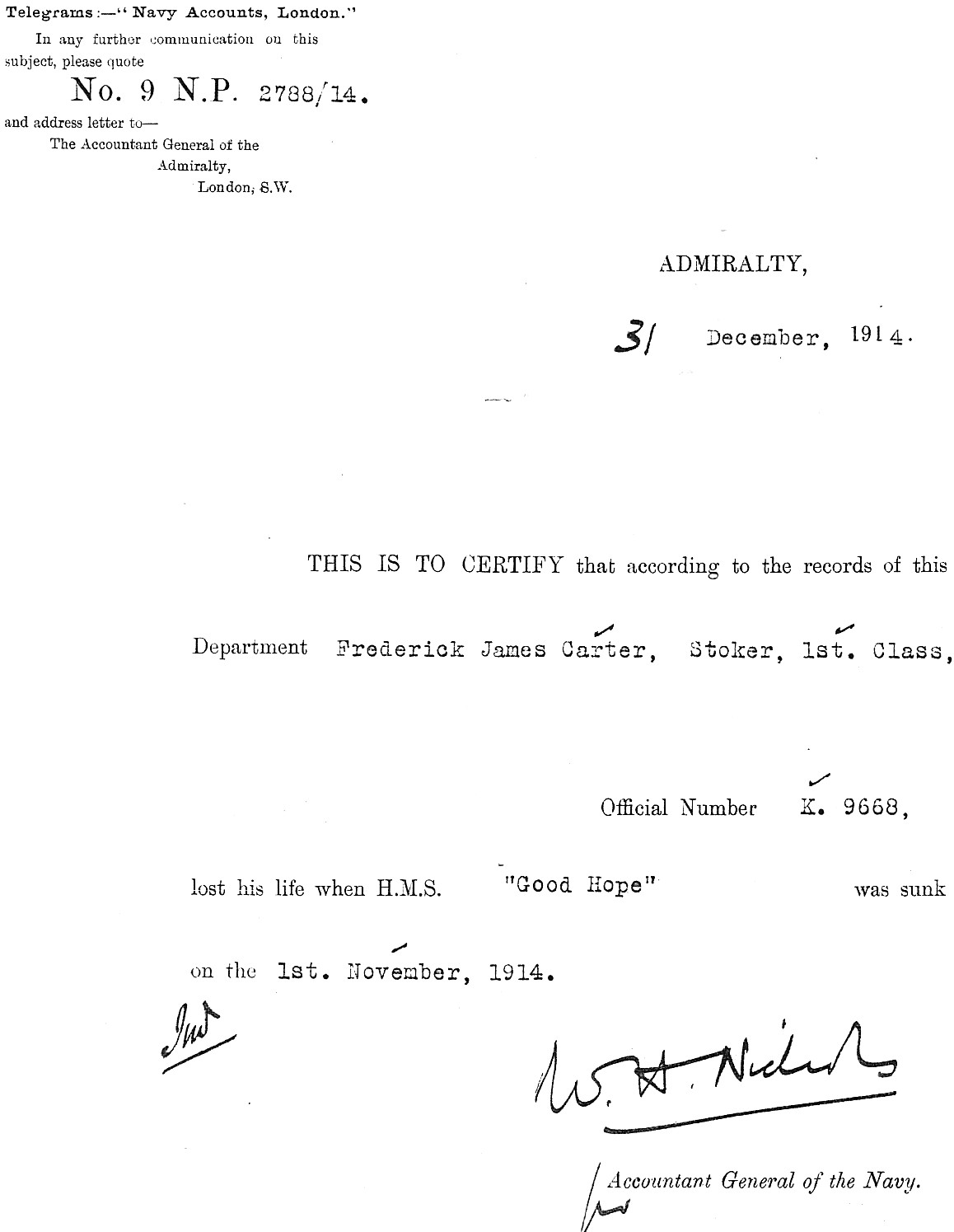 | ||
|
The Billett family would have received a
telegram similar to this one, also issued to the family of a victim of the
Battle of Coronel. It must have been little consolation to receive such
scant detail of the circumstances surrounding the death of a loved one. |
Decoration | ||
|
Walter Billett received three medals posthumously, including the 1914-15 Star. Royal Naval personnel were not in receipt of the 1914 Star (issued only to servicemen who saw active service in the early weeks of the war and these were usually involved directly in the initial battle and retreat from Mons). Instead, although he was involved in the initial phase of the War, the 1914-15 Star was awarded and we have, in November 2019, received a photograph of Walter Billett's medals and Death Plaque from his great-niece, Yvonne Gibbs:
| ||
BELOW:
Walter Billett's medal award roll, which clearly shows the Star ('St"),
Victory Medal ('V') and British War Medal ('B'). The record also
confirms that Walter's rank was 'Boy 1st Class'. The 'FR' shows
that the medals were issued to the father and the code on the right
includes the initials 'IC' for 'Index Casualty'. | ||||
 |
Commemoration | ||
Walter Billett’s inscription on the South Twerton School memorial lists him as ‘AB’ or ‘Able Seaman’. This is the rank above ‘Boy 1st Class’; there is however no evidence of him attaining the rank of AB while in service and multiple official documents confirm his rank as 'Boy 1st Class'.
| ||
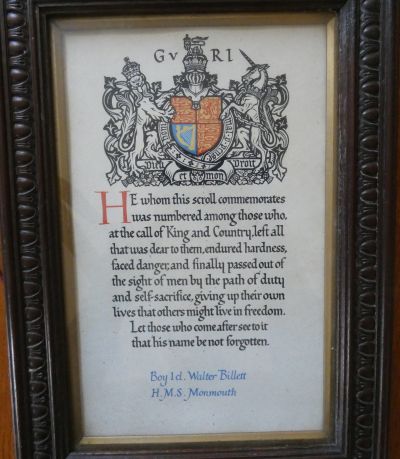 | ||
|
An official missive from the King may have
provided some crumbs of comfort. |
|
Royal Naval War Memorial, Plymouth Walter Billett is commemorated on this important national Naval memorial in Plymouth. |
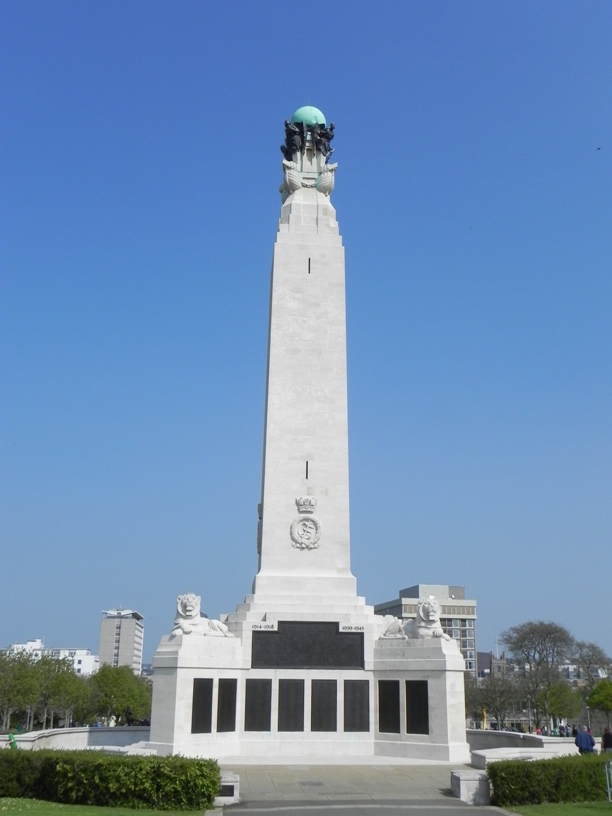 | ||
| The Naval Memorial in Plymouth and the
panel bearing the name of Walter Billett. (Photo courtesy of Rachel Sanders) |
|
Bath War Memorial See separate page for details of the Bath War Memorial. Walter Billett's inscription: |
 |
|
Walcot Parish Memorial, St Swithins Church We know that the Billett family moved to Pera Road, Walcot before 1911 and Walter is listed on the parish war memorial in the parish church, which takes the form of two white marble tablets, mounted either side of the entrance, on the rear wall of the church. Please see the separate Walcot Parish Memorial page for more details of this memorial. Walter's inscription: |
St. Andrew's MemorialWalter Billett was originally commemorated on a memorial in St. Andrew's Church, Bath. This memorial did not survive the bombing of the church in 1942. Details are on the Walcot Parish Memorial page. His inscription is just legible in this 1921 photograph: |
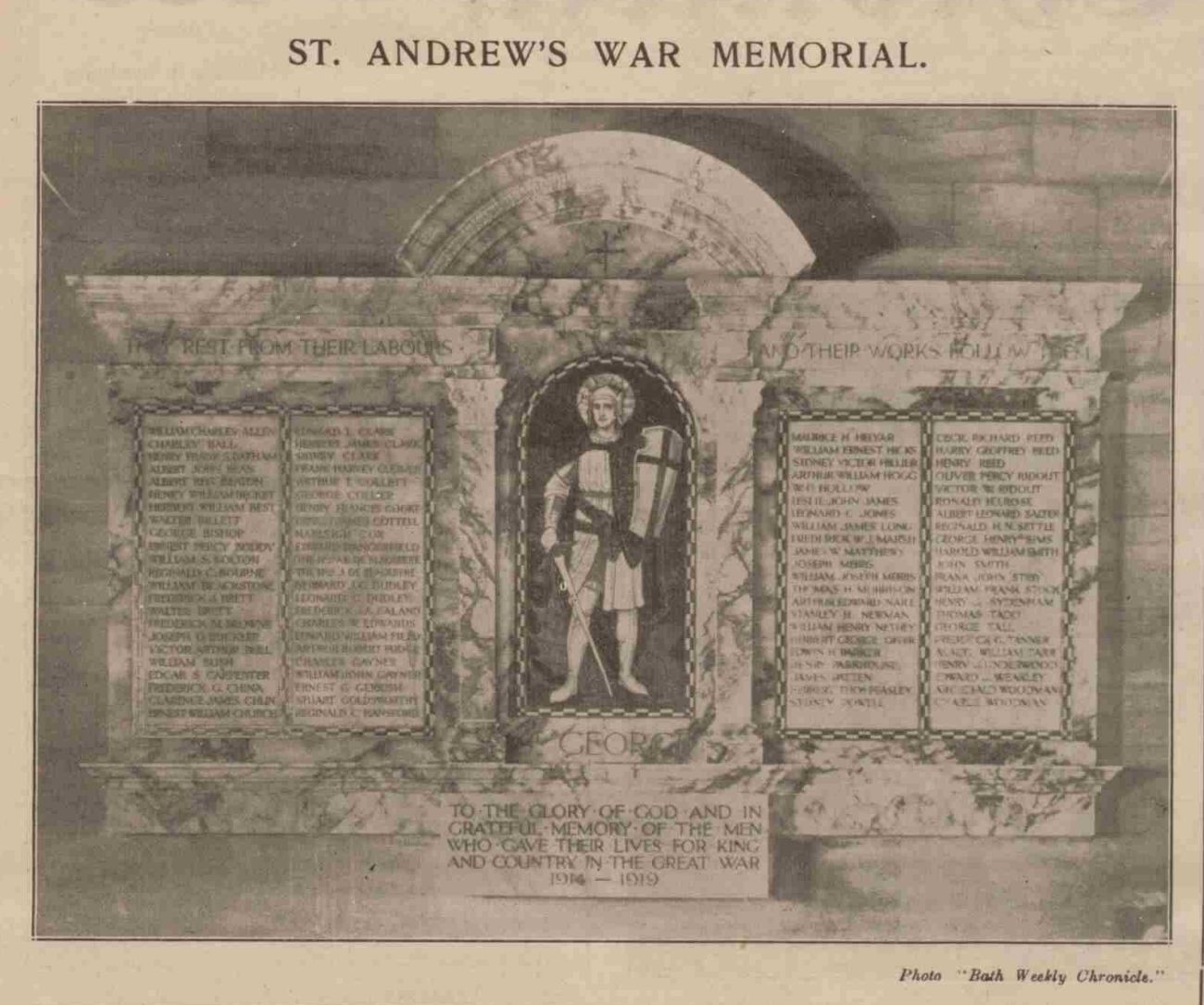 |
The Coronel Battle Memorial, Coronel, ChileWhile this memorial in the town of Coronel does not bear individual names, it still honours those who lost their lives so far from home in the early weeks of WW1. |
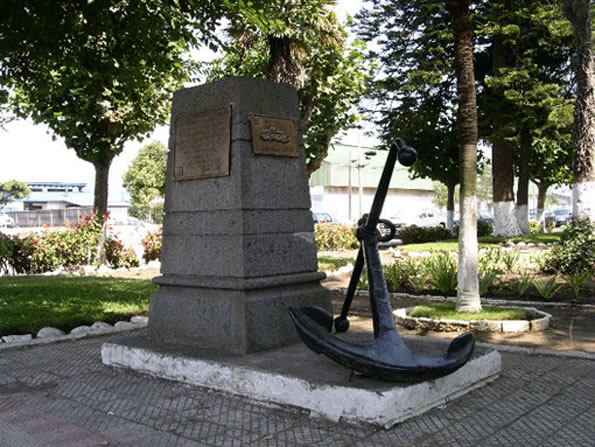 |
Living Relatives | ||
It was wonderful to hear from Yvonne Gibbs (Walter Billett's great-niece through his sister Lilian) in November 2019. Yvonne provided us with several of the images used above, including the portrait of Walter Billett at the top of the page which spent many years in a locket, hence the round shape and the wear to the edges. It is a treasured artefact within the family. Yvonne also sent this photograph of Walter Billett's mother (Ellen) and sister (Lilian) in the 1940s, with Lilian's grandson Ronald (Yvonne's elder brother):
It would be great to hear from any other living relatives of Walter Billett. We know from public sources such as censuses and www.bathbmd.co.uk that:
Please get in touch!If you have any further information on Walter Billett, or want to suggest corrections / improvements for this page, please use the Contact page to get in touch. | ||
Further Reading | ||
For more details on the specific circumstances of Walter
Billett’s contribution to the War:
| ||
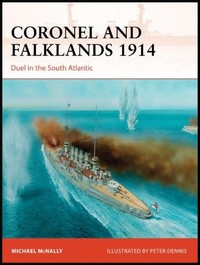 | ||